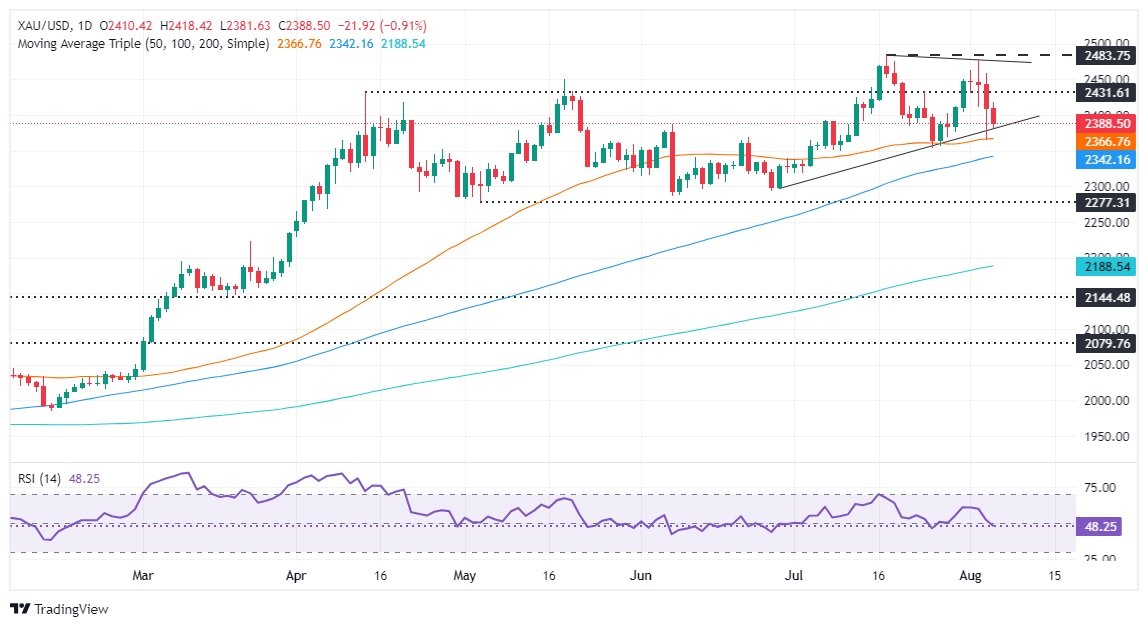- Gold prices fell below $2,400, trading at $2,389, extending losses for a second consecutive day.
- Rising US Treasury yields and a stronger US dollar weigh on gold prices.
- Geopolitical tensions in the Middle East, with Hezbollah attacks in northern Israel, could support gold as a safe haven.
Gold prices fell below $2,400 on Tuesday, extending losses for the second consecutive day as US Treasury yields rose amid an improvement in market sentiment. Rising tensions in the Middle East limited losses in the golden metal. At the time of writing, XAU/USD is trading at $2,389, down 0.82%.
The recovery in financial markets resumed on Tuesday, as the Nikkei rebounded and closed 10% above its opening price, after a 12% drop on Monday. European and US stock indices therefore recorded solid gains.
Apart from this, the Dollar remains firm, a headwind for gold prices. The US Dollar Index (DXY), which tracks the performance of the Greenback against six currencies, rose 0.30% to 102.97.
Another reason for the non-yielding metal’s fall is high US yields. The coupon on the benchmark 10-year US bond rose ten basis points (bps) to 3.892%, even as traders brace for a 50-bps interest rate cut by the Federal Reserve at the upcoming meeting in September.
However, geopolitical concerns persist after Hezbollah launched attacks in northern Israel. An escalation of the conflict could strengthen gold’s outlook and even pave the way for a recovery of $2,400.
At the central bank level, Federal Reserve policymakers, led by Mary Daly of the San Francisco Fed, said the risks of dual mandates had been balanced and they were open to cutting borrowing costs at upcoming meetings.
Daily Market Drivers Roundup: Gold price on the defensive amid risk-on sentiment
- Concerns about a US recession have faded, as market sentiment shows. Despite this, traders expect the Federal Reserve (Fed) to cut interest rates by 50 basis points at its September meeting.
- Market participants found some relief following the release of the ISM Services PMI, which revealed that the economy continues to expand at a healthier pace following a disappointing ISM Manufacturing PMI report and a disappointing US employment report.
- A deterioration in market sentiment is expected to continue to weigh on traders as fears of a US recession triggered a sell-off across major stock indices.
- The Fed left rates unchanged last week but indicated that favorable inflation data and further weakness in the labor market could prompt action.
- The CME FedWatch tool shows the odds of a 50bps Fed rate cut at the September meeting have dropped to 69.5% from 85% on Monday.
Technical Analysis: Gold Price Drops and Holds Around $2,360
Gold price falling below $2,400 could pave the way for a break below key support levels, dragging prices towards the May 3 low of $2,277. Momentum shifted aggressively to bearish, as shown by the Relative Strength Index (RSI).
If XAU/USD breaks below the 50-day simple moving average (SMA) at $2,366, this would exacerbate a drop to the 100-day SMA at $2,342, followed by a trendline support around $2,316. Once overcome, the next support would be $2,300.
Conversely, if buyers reclaim $2,400, the next resistance would be the psychological mark of $2,450. A break of the latter will expose the August 2 peak at $2,477, followed by the all-time high at $2,483 before $2,500.
Gold FAQs
Gold has played a pivotal role in human history as it has been widely used as a store of value and a medium of exchange. Today, apart from its luster and use for jewelry, the precious metal is considered a safe haven asset, meaning it is considered a good investment in turbulent times. Gold is also considered a hedge against inflation and currency depreciation as it is not dependent on any particular issuer or government.
Central banks are the largest holders of gold. In order to support their currencies in turbulent times, central banks tend to diversify their reserves and buy gold to improve the perception of the strength of the economy and the currency. High gold reserves can be a source of confidence in a country’s solvency. Central banks added 1,136 tonnes of gold worth about $70 billion to their reserves in 2022, according to data from the World Gold Council. This is the largest annual purchase on record. Central banks in emerging economies such as China, India and Turkey are rapidly increasing their gold reserves.
Gold has an inverse correlation with the US Dollar and US Treasury bonds, which are the main reserve and safe haven assets. When the Dollar depreciates, the price of Gold tends to rise, allowing investors and central banks to diversify their assets in turbulent times. Gold is also inversely correlated with risk assets. A rally in the stock market tends to weaken the price of Gold, while sell-offs in riskier markets tend to favor the precious metal.
Gold prices can move due to a wide range of factors. Geopolitical instability or fears of a deep recession can cause the price of Gold to rise rapidly due to its status as a safe haven asset. As a non-yielding asset, Gold prices tend to rise when interest rates fall, while rising money prices often weigh down the yellow metal. Still, most of the moves depend on how the US Dollar (USD) performs, as the asset is priced in dollars (XAU/USD). A strong Dollar tends to keep Gold prices in check, while a weaker Dollar is likely to push Gold prices higher.
Source: Fx Street
I am Joshua Winder, a senior-level journalist and editor at World Stock Market. I specialize in covering news related to the stock market and economic trends. With more than 8 years of experience in this field, I have become an expert in financial reporting.






